iter
HPR Glider Driver
- Joined
- Jun 9, 2012
- Messages
- 2,144
- Reaction score
- 73
Status update: I successfully certify L1 with Vulcan at TCC October Skies on Oct. 19 using a CTI H54 motor.
Vulcan now has 21 flights and counting: 4xG54, 2xG69, 2xH54, 1xH73, 5xH112, 3xH123, 4xI49.
First flight (10/9/2012; video credit: David Springsteen):
[video=youtube;DOoQHrTUDTY]https://www.youtube.com/watch?v=DOoQHrTUDTY[/video]
Second flight (TCC 10/19/2012, L1 flight @ TCC October Skies): https://www.youtube.com/watch?v=-2NGnNFEE9Y (video credit: Steve Sawyer)
Third flight (TCC 10/20/2012 @TCC October Skies): https://www.youtube.com/watch?v=q5Fk8XjnliY (video credit: "Minimum Wage" Mike)
Fourth flight (LUNAR 10/27/2012 @LUNAR Moffett): https://www.youtube.com/watch?v=Qt2NY6224kk (video credit: rbelknap)
Fifth flight (11/3/2012): https://www.youtube.com/watch?v=UOeQk790-yk (video credit: Nolan Leake)
Sixth & seventh flights (11/24/2012): www.youtube.com/watch?v=mTV1_q2oiHw (video credit: David Springsteen)
Eighth flight (1/5/2013 @LUNAR Snow Ranch): https://www.youtube.com/watch?v=sWmTcx7AKP0 (video credit: "qquake2k" Jim)
Ninth flight (1/12/2013 @SARG): https://www.youtube.com/watch?v=RIbdjWSHezg (video credit: "qquake2k" Jim)
Tenth flight (2/16/2013 @LUNAR Moffett): no video
Eleventh & twelfth flights (2/17/2013 @SCCMAS): https://www.youtube.com/watch?v=sTayTlVdOdQ (video credit: Walter Colby)
Thirteenth & fourteenth flights (2/24/2013 @SCCMAS): https://youtu.be/2CNbHRUeeqE (video credit: Walter Colby)
Fifteenth flight (3/2/2013 @LUNAR Snow Ranch)
Sixteenth flight (5/19/2013 @ TCC Dairy Aire)
Seventeen-nineteen: SCCMAS airshow 2013
Twentieth & Twenty-first (7/6/2014 @ SCCMAS): https://youtu.be/8Owa_4T7e68
Photos from October Skies by Martin Hall (hi res versions and many more photos at https://konoctipirate.smugmug.com/Rockets/October-Skies-2012-Friday):
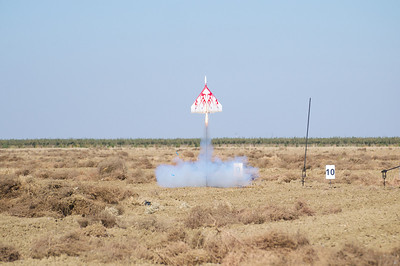
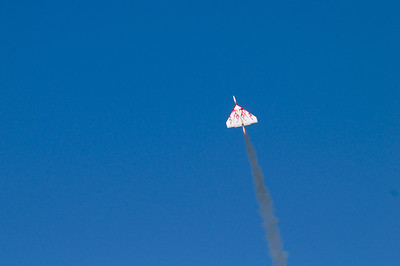
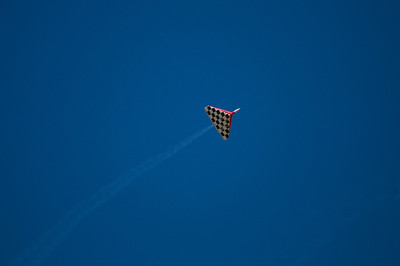
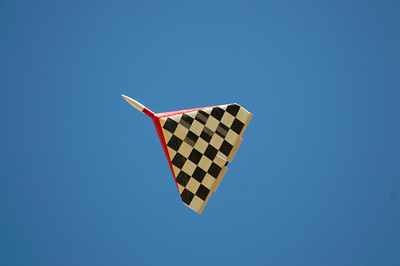
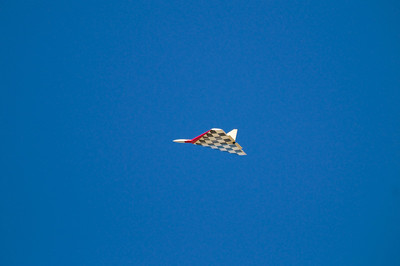
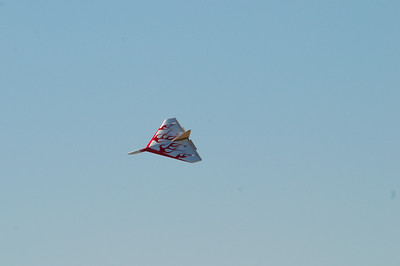
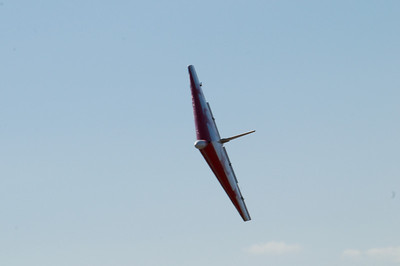
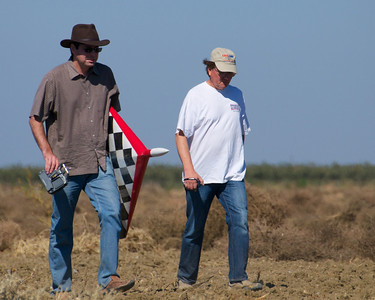

Another photo from Martin, from January 5 Snow Ranch (more at https://konoctipirate.smugmug.com/Rockets/Snow-Ranch-LUNAR-010513/27431147_jvKr9J)

Below is my original post from 9/13/2012. Read on to follow original and ongoing development.
I'm building an RCRG for my L1 cert. The basic specs are:
Wingspan: 43"
Airfoil: NACA0015
L1 attempt motor: H54 (3-grain pro-29); 38mm inner tube can accommodate I49 or even I59
Fuselage: 54mm tube
Custom foam cores by https://www.flyingfoam.com/
The name derives from the planform and its superficial similarity to Avro Vulcan.
This build incorporates my experience from this project. The main takeaway is that a small glider is impractical for HPR on two counts: 1, it's difficult to see at altitude; 2, L1 motors can accelerate it beyond structural limits. Simulations suggest the 2' glider might reach 600mph, which is well beyond the airframe's capacity (and my capacity to control it). Therefore my goals with this design is to build a larger, draggier, heavier glider. This is contrary to my intuition and experience and a novel exercise in this sense.
The wings are quite massive--larger than any of my existing models. The 2' glider and my R/C transmitter give a sense of scale.
Ari.



Vulcan now has 21 flights and counting: 4xG54, 2xG69, 2xH54, 1xH73, 5xH112, 3xH123, 4xI49.
First flight (10/9/2012; video credit: David Springsteen):
[video=youtube;DOoQHrTUDTY]https://www.youtube.com/watch?v=DOoQHrTUDTY[/video]
Second flight (TCC 10/19/2012, L1 flight @ TCC October Skies): https://www.youtube.com/watch?v=-2NGnNFEE9Y (video credit: Steve Sawyer)
Third flight (TCC 10/20/2012 @TCC October Skies): https://www.youtube.com/watch?v=q5Fk8XjnliY (video credit: "Minimum Wage" Mike)
Fourth flight (LUNAR 10/27/2012 @LUNAR Moffett): https://www.youtube.com/watch?v=Qt2NY6224kk (video credit: rbelknap)
Fifth flight (11/3/2012): https://www.youtube.com/watch?v=UOeQk790-yk (video credit: Nolan Leake)
Sixth & seventh flights (11/24/2012): www.youtube.com/watch?v=mTV1_q2oiHw (video credit: David Springsteen)
Eighth flight (1/5/2013 @LUNAR Snow Ranch): https://www.youtube.com/watch?v=sWmTcx7AKP0 (video credit: "qquake2k" Jim)
Ninth flight (1/12/2013 @SARG): https://www.youtube.com/watch?v=RIbdjWSHezg (video credit: "qquake2k" Jim)
Tenth flight (2/16/2013 @LUNAR Moffett): no video
Eleventh & twelfth flights (2/17/2013 @SCCMAS): https://www.youtube.com/watch?v=sTayTlVdOdQ (video credit: Walter Colby)
Thirteenth & fourteenth flights (2/24/2013 @SCCMAS): https://youtu.be/2CNbHRUeeqE (video credit: Walter Colby)
Fifteenth flight (3/2/2013 @LUNAR Snow Ranch)
Sixteenth flight (5/19/2013 @ TCC Dairy Aire)
Seventeen-nineteen: SCCMAS airshow 2013
Twentieth & Twenty-first (7/6/2014 @ SCCMAS): https://youtu.be/8Owa_4T7e68
Photos from October Skies by Martin Hall (hi res versions and many more photos at https://konoctipirate.smugmug.com/Rockets/October-Skies-2012-Friday):









Another photo from Martin, from January 5 Snow Ranch (more at https://konoctipirate.smugmug.com/Rockets/Snow-Ranch-LUNAR-010513/27431147_jvKr9J)

Below is my original post from 9/13/2012. Read on to follow original and ongoing development.
I'm building an RCRG for my L1 cert. The basic specs are:
Wingspan: 43"
Airfoil: NACA0015
L1 attempt motor: H54 (3-grain pro-29); 38mm inner tube can accommodate I49 or even I59
Fuselage: 54mm tube
Custom foam cores by https://www.flyingfoam.com/
The name derives from the planform and its superficial similarity to Avro Vulcan.
This build incorporates my experience from this project. The main takeaway is that a small glider is impractical for HPR on two counts: 1, it's difficult to see at altitude; 2, L1 motors can accelerate it beyond structural limits. Simulations suggest the 2' glider might reach 600mph, which is well beyond the airframe's capacity (and my capacity to control it). Therefore my goals with this design is to build a larger, draggier, heavier glider. This is contrary to my intuition and experience and a novel exercise in this sense.
The wings are quite massive--larger than any of my existing models. The 2' glider and my R/C transmitter give a sense of scale.
Ari.



Last edited:






















